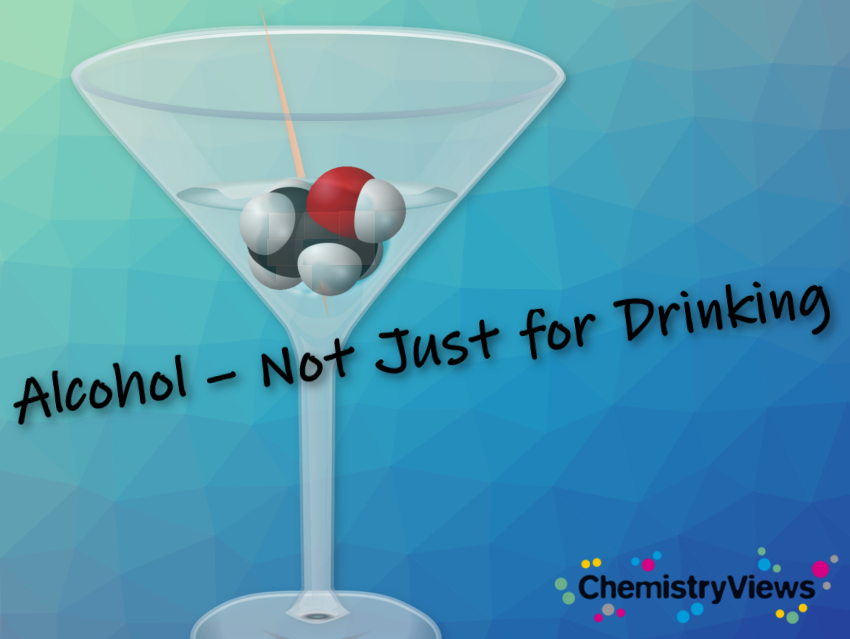Alcohol in Chemistry and in Our Drinks
In chemistry as in our daily lives, alcohol comes in various forms, such as beer, wine, vodka, sake, whiskey or any organic compound with a hydroxyl group at a saturated carbon atom. When we drink alcohol, we hope that there is only ethanol involved. However, still it is amazing how this one simple molecule, ethanol, can be at the root of so much human misery [1]: lifted inhibitions, childish tomfoolery, problems with speech, confusion, loss of orientation, inability to move in a coordinated fashion, etc.
Ethanol
Early on, when studying chemistry, we have learned from K. Peter C. Vollhardt that ethanol is toxic. Ethanol has a non-specific, reversible depressant effect on the central nervous system [2]. According to the World Health Organization (WHO), approx. 3.3 million deaths, 5.9 % of all global deaths, resulted from alcohol consumption in 2012. But still, we enjoy it. Among the top alcohol consuming countries are Lithuania (14.4 liters/capita (aged 15 and over), 2012), Estonia (12.2 L/capita), France (11.7 L/capita) and among the low consumers are Turkey (1.6 L/capita) and Israel (2.7 L/capita) [3].
Large amounts of ethanol are used as engine fuel, especially in Brazil, and as fuel additive. The world fuel ethanol production was 24,570 Milions of gallons in 2014 according to the Renewable Fuels Association (RFA) with the USA and Brazil leading with 14,300 und 6,190 Milllion gallons, respectively [4]. Brazil, which has the largest biofuel program worldwide, produces ethanol for fuel from sugarcane; the US has a corn-based industry.
In fuel cells ethanol is of great interest [5]. Direct alcohol fuel cells (DAFCs) continuously convert the chemical energy of an alcohol fuel to electricity. Ethanol offers higher energy density compared to methanol and has a lower crossover rate from the anode to the cathode.
Methanol
Methanol is something we better don’t have in our drink; it causes blindness and death. Methanol is toxic, highly flammable but nevertheless it is extremely attractive, for example, as fuel or for the production of chemicals such as acetic acid and formaldehyde [6]. Methanol is seen as an alternative for our current energy sources and could be a solution for energy storage [7].
In biotechnological production processes methanol is not used very much. Most microbial organisms cannot utilize methanol as a carbon and energy source. Methanol, for example, often inactivates lipases during biodiesel production. Researchers work to make industrial lipases, which catalyze the transesterification of fatty acids, more stable [8]. Researchers from Jülich, Germany, succeeded in changing the bacterial strain Cornybacterium glutamicum so that it can process methanol. Prior to its industrial use, however, the implementation of the alcohol by the bacterium has to be further improved [9].
Shale gas, containing primarily methane, can be economically viable converted into methanol [10]. Also coal is converted to methanol. Methanol then is subsequently polymerized into olefines. China’s coal to chemicals projects especially focus on the latter [11]. In the indirect coal liquefaction (ICL) process first coal is converted into syngas. Then, in the methanol synthesis process, syngas is converted to methanol. In 2014 China in total produced 50 % of the world’s methanol [12]. The share is supposed to rise as is the demand.
References
[1] Klaus Roth, Chemistry of a Hangover — Alcohol and its Consequences, ChemViews Mag. 2011. DOI: 10.1002/chemv.201000074
[2] K. Peter C. Vollhardt, Organische Chemie, Wiley-VCH, Weinheim, 1990. ISBN 3-527-26912-6
[3] Alcohol Consumption, OECD 2015. DOI: 10.1787/e6895909-en (Accessed on 20 August 2015)
[4] World Fuel Ethanol Production, Renewable Fuels Association (RFA) 2015. (Accessed on 20 August 2015)
[5] Heiko Kuhn, Enhanced Ethanol Oxidation Using Trimetallic Nanoalloys, ChemistryViews.org 2015. and Da-Bing Huang, Pei-Lei He, Qiang Yuan, Xun Wang, Size-Controllable Synthesis of Trimetallic RhPdPt Island-Shaped Nanoalloys with Enhanced Electrocatalytic Performance for Ethanol Oxidation in Alkaline Medium, Chem. Asian J. 2015. DOI: 10.1002/asia.201403310
[6] LyondellBasell Restarts Methanol Plant, ChemistryViews.org 2014.
[7] George A. Olah, Alain Goeppert, G. K. Surya Prakash, Beyond Oil and Gas: The Methanol Economy, Wiley-VCH, Weinheim, 2009. ISBN: 3527324224
[8] Uta Goebel, Methanol Inactivation of Lipases, ChemistryViews.org 2014. and M. Lotti, J. Pleiss, F. Valero, P. Ferrer, Effects of methanol on lipases: Molecular, kinetic and process issues in the production of biodiesel, Biotechnol. J. 2014. DOI: 10.1002/biot.201400158
[9] Forschnungszentrum Jülich, Institut für Bio- und Geowissenschaften 2015.
[10] Victoria M. Ehlinger, Kerron J. Gabriel, Mohamed M. B. Noureldin, Mahmoud M. El-Halwagi, Process Design and Integration of Shale Gas to Methanol, ACS Sustainable Chem. Eng. 2014, 2 (1), 30–37. DOI: 10.1021/sc400185b
[11] China Coal Chemical Industry Analysis, IHS Chemical
[12] Developments in China’s methanol market and implications for global supply, Argus Media Ltd., London, UK, 2015.
Archives
 |
 |
 |
 |
 |
|
Chemistry of a Hangover — Alcohol and its Consequences How can a tiny molecule like ethanol be at the root of so much human misery? |
Caipirinha is not only the World Cup 2014 cocktail, but Brazil’s national cocktail |
Fermentation Process in Wine Making Video describes, with the help of Dr Nol, the alcoholic fermentation process that is the basis of wine production |
Sparkling Wine, Champagne & Co Looking a bit deeper into the glass we discover that there is a great deal of chemistry involved … only chemistry can be this tingling |
Beer owes its marvelous flavor to a great deal of chemistry |
 |
 |
 |
 |
|
Angel’s Share Authenticates Rare Wines Carbon dating of ethanol in wine corks verifies vintage in sealed bottles |
Enhanced Ethanol Oxidation Using Trimetallic Nanoalloys RhPdPt nanoalloys display a high electrocatalytic activity toward ethanol oxidation |
BASF’s Investment on U.S. Gulf Coast BASF continues to evaluate natural gas-based investment on the U.S. Gulf Coast |
Alcohol Metabolism Causes DNA Damage Study using human cells establishes linkages between alcohol metabolism and acetaldehyde-DNA damage causing cancer |
To celebrate the 5th anniversary of ChemistryViews.org, for five months (June – October) on the 21st of each month we highlight great pieces of content from the archives along with newly created features.
- See more articles that explore ChemistryViews.org




